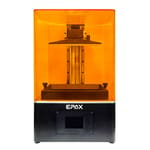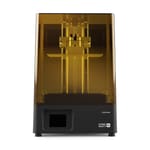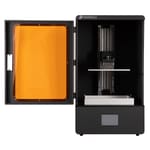The E10 is Epax’s move into the realm of large-sized budget resin 3D printers. Having released a series of successful but pricier resin printers in the past, Epax has now released what is, in a sense, a more affordable version of its flagship printer, the Epax X10.
The Epax E10 offers an 8.9-inch 4K monochrome screen and a total build volume of 192 x 120 x 250 mm.
Nothing to blow you out of your socks these days, you say? Well, hold tight. The E10 is compatible with even larger LCD panels and can house the upcoming Epax 10.1-inch 5K mono screen. With a 4920 x 2880 pixel resolution, you can print at a 45-micron accuracy over an even bigger area of 216 x 135 mm. Pretty out of the ordinary, we’d say.
Read on to see what else there is to know about the E10.
Features
Monochrome Screen
If you haven’t been living under a resin rock for the last year, you will likely be familiar with the recent change in technology and the benefits it has brought. If not, here is a quick recap. Monochrome screens allow for better light permeability compared to the formerly used RGB ones, which result in faster layer curing times as well as a prolonged screen lifespan due to less light exposure.
To put it in numbers, layer curing times that used to take around 6-8 seconds have now been cut down to 2-3 seconds, and the lifetime of the screen has quadrupled to ~2000 h of use.
Needless to say, the Epax E10 features it.
Resolution
The second big change that resin 3D printers have undergone lately is the inclusion of 4K HD screens. As a larger print area also means a larger granularity of pixels, it is only natural for manufacturers to strive for higher resolutions. With its 192 x 120 mm build area and a 3840 x 2400, 8.9-inch 4K screen, the Epax E10 can churn out prints at a 51-micron resolution, on par with the competition.
Epax takes it a step further, though, and plans on releasing an upgraded version of the E10 as well as an upgrade kit. This would equip the printer with a 10.1-inch, 5K LCD that offers a bigger print area of 216 x 135 mm, at an even better resolution of 45 microns (4920 x 2800 pixels). That means bigger prints in, theoretically, better detail.
Improved FEP Foil
To cure the resin in the top-down process, resin 3D printers feature a transparent vat bottom, typically consisting of an FEP film. Epax, however, uses an nFEP (non-FEP) foil made from a special Teflon material. These were typically used in DLP and SLA machines due to the technologies’ higher requirements.
Epax claims the foil is smoother than conventional FEP films and provides greater air permeability, resulting in less vacuum suction force. In general, the larger a print is, the more peel force applies every time the print plate lifts after curing a layer. This can lead to print artifacts or even complete failures, so a potentially superior non-stick surface would be welcomed.
Moulded Vat and Build Plate
Presumably, to keep the costs down, Epax went for a molded plastic composite vat as well as a partially molded build plate. The print surface itself is a metal plate. Whether a plastic or metal vat is best to keep considerable amounts of resin at bay over time is open for discussion.
From our experience, we have yet to find a real drawback for the plastic ones. You should be careful with your full resin vat, metal or not, but if you feel like you want a little extra base weight to it, Epax overs additional metal vats.
ChiTu Firmware
The Epax E10 houses a ChiTu mainboard and runs on ChiTu firmware, which offers a well-designed user interface that lets you control the printer via its 3.5-inch color touchscreen.
As such, ChituBox might be your go-to slicer. It is a highly capable resin slicer with everything you need for successful resin 3D printing. However, the Epax E10 can be used with multiple slicers, such as Lychee – another powerful resin slicer.
Further Features
- Connectivity – the Epax E10 offers USB and Ethernet connection, both located conveniently on the printer’s side
- Dual linear rail guides – providing the lead screw with guidance to move more precisely
- A manual bed leveling system

Price
At the time of writing, the Epax E10 Mono 4K version sells for ~$700. Compared to the same-sized competitors, there are cheaper ones out there, but then again, they don’t offer the possibility to upgrade to 5K.
As we have it from Epax, the future upgrade requires a larger screen (duh!) as well as a new mainboard, which in total will set you back an additional few hundred dollars, totaling out to what is likely to be ~$1000.

Reviews
The Epax E10 has been out for a short time now. A fair few reviews can be found throughout the usual channels, attesting to the machine’s solid performance – as you can expect from a resin 3D printer nowadays.
So far, no reviews of the 5.5K upgrade have surfaced, but Epax has stated that it is sending out a couple of beta units. We will be one of the lucky ones, so stay tuned for our hands-on check.

Tech Specs
General Specifications
- Technology: LCD
- Type: Resin
- Year: 2020
- Assembly: Fully-assembled
- Manufacturer: Epax
3D PRINTING SPECIFICATIONS
- Build Volume: 4K: 192 x 120 x 250 mm; 5K: 216 x 135 x 250 mm
- Layer Height: 10 microns
- XY Resolution: 4K: 3840 x 2400 pixels (51 microns); 5K: 4920 x 2800 pixels (45 microns)
- Z-axis positioning accuracy: 0.01 mm
- Printing Speed: N/A
- Bed-Leveling: Manual
- Display: 3.5-inch touchscreen
- Third-Party Materials: Yes
- Materials: 405 nm UV resin
SOFTWARE REQUIREMENTS
- Recommended Slicer: ChiTuBox
- Operating system: Windows / macOS X / Linux
- File types: STL
- Connectivity: USB, Ethernet
DIMENSIONS AND WEIGHT
- Frame dimensions: 330 x 312 x 525 mm
- Weight: ~15.5 kg
- Boxed size: N/A
- Weight (packed): N/A

Similar Printers
You may also be interested in the following printers:
For further information, feel free to check out our Best Large Format Resin Printers Guide.
Anycubic Photon Mono X
Anycubic’s Photon Mono X boasts a slightly shorter build height, with a total print volume of 192 x 120 x 245 mm. Priced competitively, it does not feature the possibility of upgrading to a larger screen but houses other convenient features such as WiFi connectivity. A strong contender in its category.
Phrozen Sonic Mighty 4K
The Mighty 4K is another capable resin 3D printer. Housing a 9.3-inch LCD, it offers an even bigger build area of 200 x 125 x 220 mm, but also a smaller build height. It sells at a competitive price but has minor usability compromises such as a poky touchscreen, jobs only loadable via USB, and odd design choices such as the vat fixture or the power switch location. Nothing that takes away from the printer’s performance, though.
Peopoly Phenom
One of the largest commercially available resin 3D printers, the Peopoly Phenom, offers a staggering build volume of 276 x 155 x 400 mm but lacks the monochrome-speed of the Epax E10.
License: The text of "Epax E10: Specs, Price, Release & Reviews" by All3DP is licensed under a Creative Commons Attribution 4.0 International License.
CERTAIN CONTENT THAT APPEARS ON THIS SITE COMES FROM AMAZON. THIS CONTENT IS PROVIDED ‘AS IS’ AND IS SUBJECT TO CHANGE OR REMOVAL AT ANY TIME.






